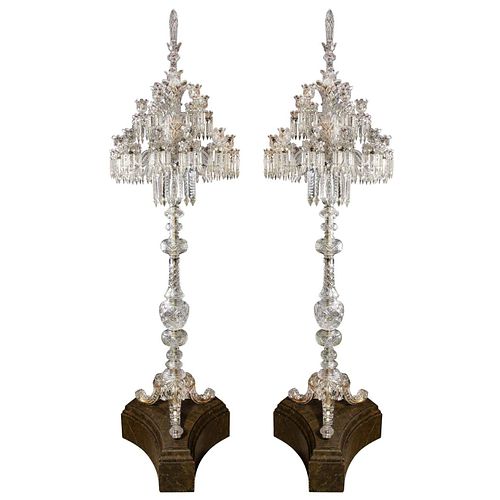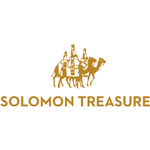Cristalleries De Baccarat, a Large Pair of French Cut Crystal 18-Light Torcheres
Lot 125
About Seller
Solomon Treasure
1050 2nd Ave #83
NY, NY 10022
United States
Four Generations of collecting exquisite European Art & Antiques.
About Auction
By Solomon Treasure
Sep 8, 2021 - Sep 22, 2021
Set Reminder
2021-09-08 17:00:00
2021-09-22 17:00:00
America/New_York
Bidsquare
Bidsquare : The Exceptional Fall Sale
https://www.bidsquare.com/auctions/solomon-treasure/the-exceptional-fall-sale-7466
The Exceptional Fall Sale - No Buyers Premium! Solomon Treasure mory@solomontreasureny.com
The Exceptional Fall Sale - No Buyers Premium! Solomon Treasure mory@solomontreasureny.com
- Lot Description
Cristalleries De Baccarat, a large pair of French cut-crystal eighteen light torcheres, early 20th century. These are extremely rare and unique standing floor chandeliers by Baccarat, Paris. Each central stem issuing eighteen out-scrolled candle branches suspending prisms and bell-flowers, on three splayed supports, the drip-pans stamped BACCARAT, attached to faux marble bases. Through the unusual clarity of the glass, the evident weight, the uniformity of the surface allowing for bold engraving and cutting, this extraordinary pair of torchères dit "de la Tsarine" showcases all the hallmarks that made Baccarat, the leading glass manufacture in France. Overall with faux marble bases: 93" high x 26" diameter Without faux marble stands: 83" high x 26" diameter Very good condition. No damages noted. All parts intact. COMPARATIVE LITERATURE: Lerch, Moscou, Splendeurs des Romanov, Exhibition catalogue, 11 July – 13 September 2009, Monaco, pp. 214-217. M. Lerch, Baccarat: la légende du cristal, Exhibition catalogue, 15 October 2014 – 4 January 2015, Paris, pp.68-69. D. Sautot, The Story of Baccarat, Paris, 1993. Cristalleries de Baccarat: The origins of the manufacture, also known as the Compagnie des Cristalleries de Baccarat, can be traced to 1764. On this year, King Louis XV accorded to the Bishop of Metz permission to establish a glass factory on his land, in the small village of Baccarat in Lorraine, in order to compete with the celebrated Bohemian production. Lorraine is traditionally a glass-making region, due to the abundance of silica in the soil and due to its large forests, which supplied the wood to fuel the ovens. Francois-Eugène de Fontenay, who joined the company in 1841, discovered that the addition of nickel oxide in the manufacturing process resulted in a perfectly clear product, 'crystal glass', that was free of discoloration and that imitated precious rock crystal. For this discovery, the Baccarat company was awarded a gold medal at the French Expositions des Produits de l'Industrie in 1844. Continually experimenting with their manufacturing process, the quality of Baccarat's 'crystal glass' improved, reaching the highest level by the end of the century. The Baccarat manufacture rapidly became a leading producer with highly skilled maître-verriers. In 1823, Baccarat participated for the first time at the National Exhibition. Louis XVIII was seduced by the quality of the pieces presented, which received the praise of the jury and the first gold medal. As a result of their success and innovations, the manufacture gradually consolidated its reputation, which allowed it to dominate the French market. Historical documents from Baccarat highlight the model for these torchères enjoyed great success. They are designed after a drawing for a model showcased at the 1867 Exposition Universelle. A pair of almost identical torchères is seen on a photograph of Baccarat's shop at 30 bis on the rue de Paradis, Paris. Some of these torchères dated from the late 19th century/20th century have appeared on the market including one pair, of smaller height, Sotheby's New York, 20 April 2007, lot 249 and one torchère sold Christie's New York, 13 April 2017, lot 178 The Russian fascination for Baccarat: In 1867, Tsar Alexander II visited the Exposition Universelle in Paris and fell in awe in the sight of Baccarat’s stand which showcased a 10 meter high twenty-four candelabrum, tables, an immense fountain more than seven meters high, vases and chandeliers. This visit initiated a long-lasting relationship with the firm and resulted in a series of commissions by the Romanov family. For example, in 1867, the Tsar ordered for the private apartments of his wife, Tsarina Maria Alexandrovna a series composed of a pedestal table, a fountain and a twenty-four candelabrum. A pair of monumental candelabra, first exhibited at the Exposition Universelle of 1878 were commissioned by the Tsar in 1896. Another pair of the same design of the later candelabra was sold Christie's New York, 13 April 2016, lot 21.Good
Condition
- Shipping Info
-
In House
-
- Payment & Auction Policies
-
Available payment options
-



 EUR
EUR CAD
CAD AUD
AUD GBP
GBP MXN
MXN HKD
HKD CNY
CNY MYR
MYR SEK
SEK SGD
SGD CHF
CHF THB
THB





















